Management Accounting Assignment for Finance Students
VerifiedAdded on 2020/04/15
|17
|3120
|37
Homework Assignment
AI Summary
This management accounting assignment solution covers various aspects of financial analysis and decision-making within a business context. Part 1 defines management accounting, contrasting it with financial accounting, and explores different types of management accounting reports like budgets, cost reports, and variance analysis. It also delves into the role of management accountants, different cost classifications (fixed, variable, direct, indirect, etc.), and their impact on decision-making. The solution includes calculations for marginal and absorption costing, production optimization under constraints, and the impact of investment decisions. Part 2 analyzes the financial performance of a company, discussing the importance of managing fixed and variable costs, the impact of labor hour constraints, and the benefits of just-in-time inventory management. It also covers the budgeting process, its functions, advantages, and disadvantages. Part C focuses on flexible budgeting, providing detailed monthly budgets for sales, cash collections, production, direct material purchases, and cash flow. Finally, Part D analyzes the impact of actual raw material purchases and utilization on the budget.
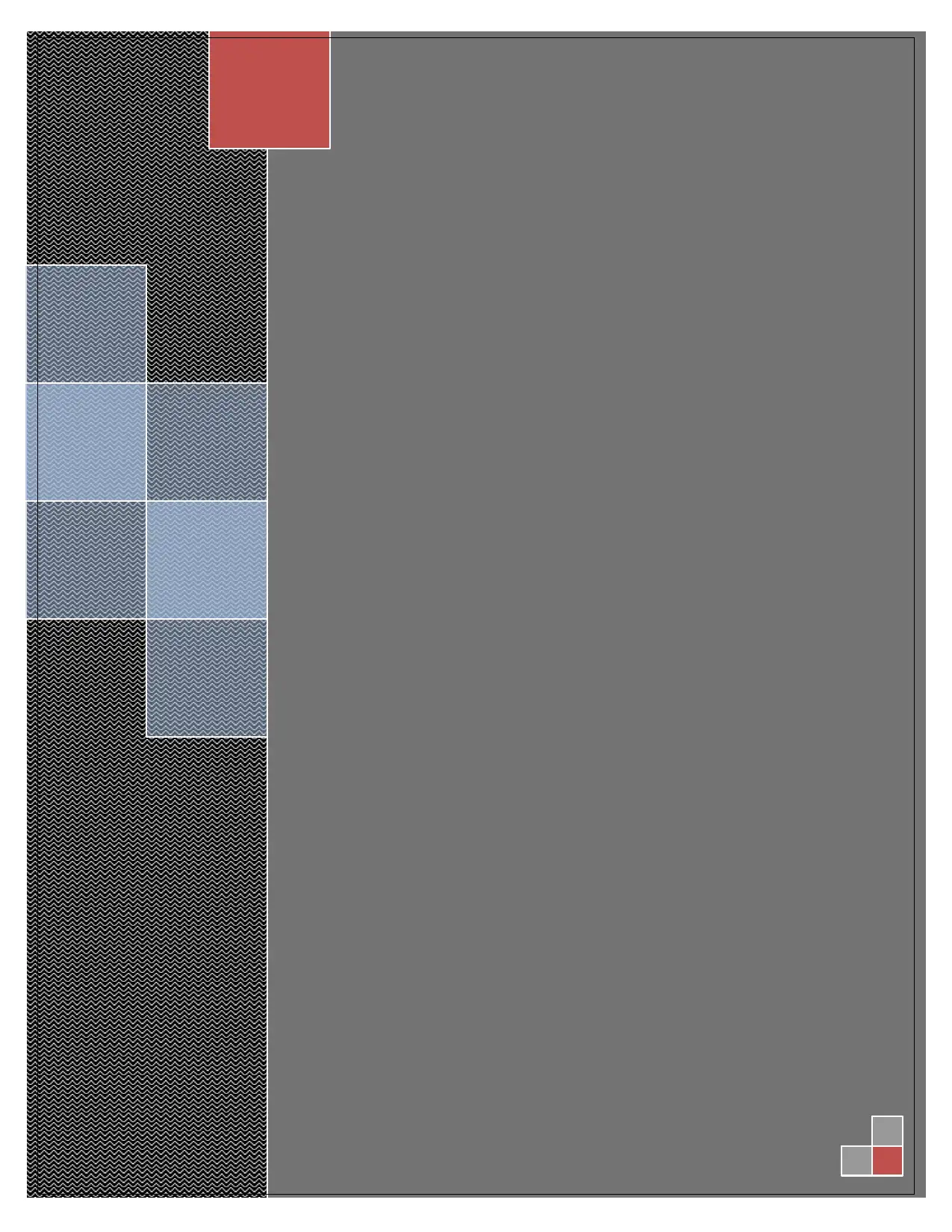
Paraphrase This Document
Need a fresh take? Get an instant paraphrase of this document with our AI Paraphraser
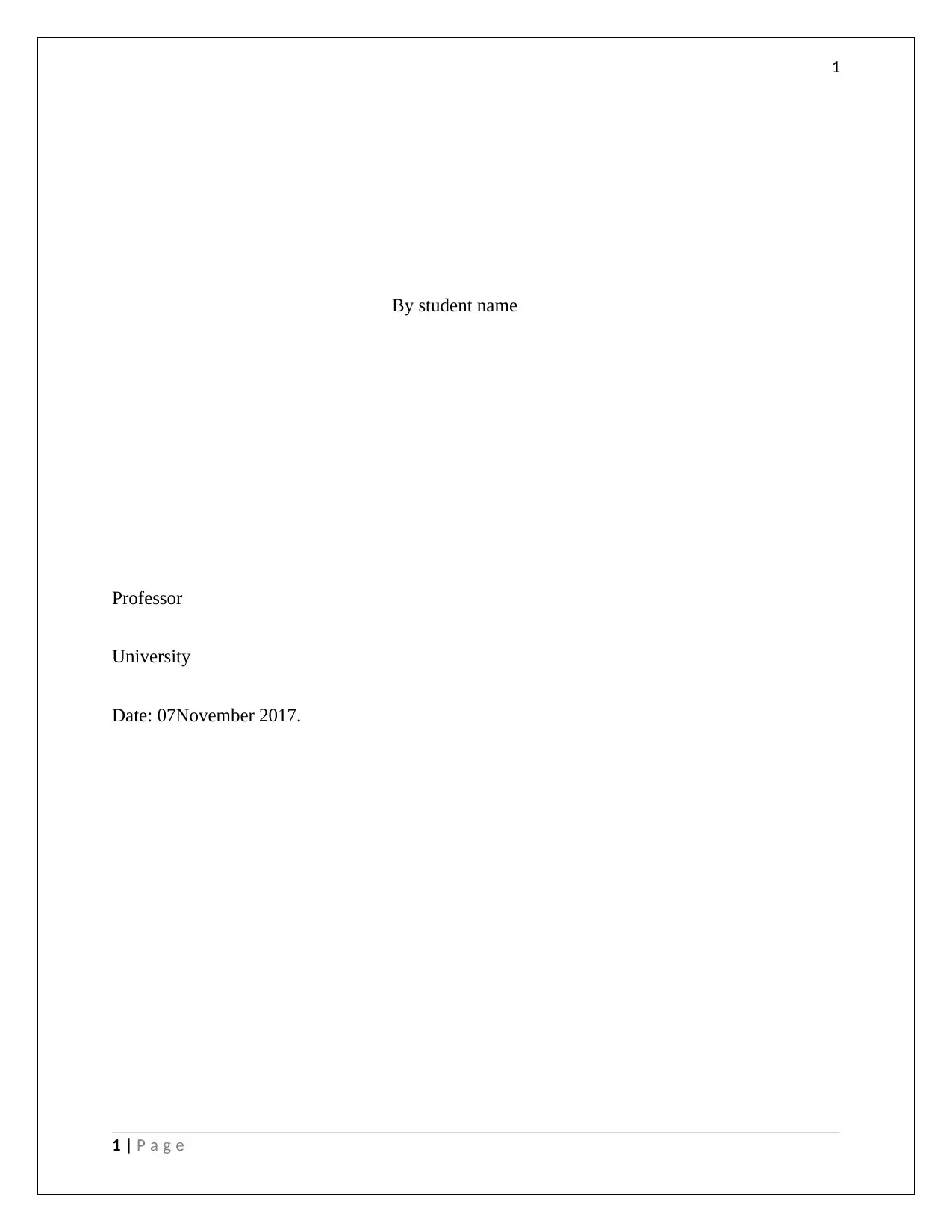
1
By student name
Professor
University
Date: 07November 2017.
1 | P a g e
By student name
Professor
University
Date: 07November 2017.
1 | P a g e
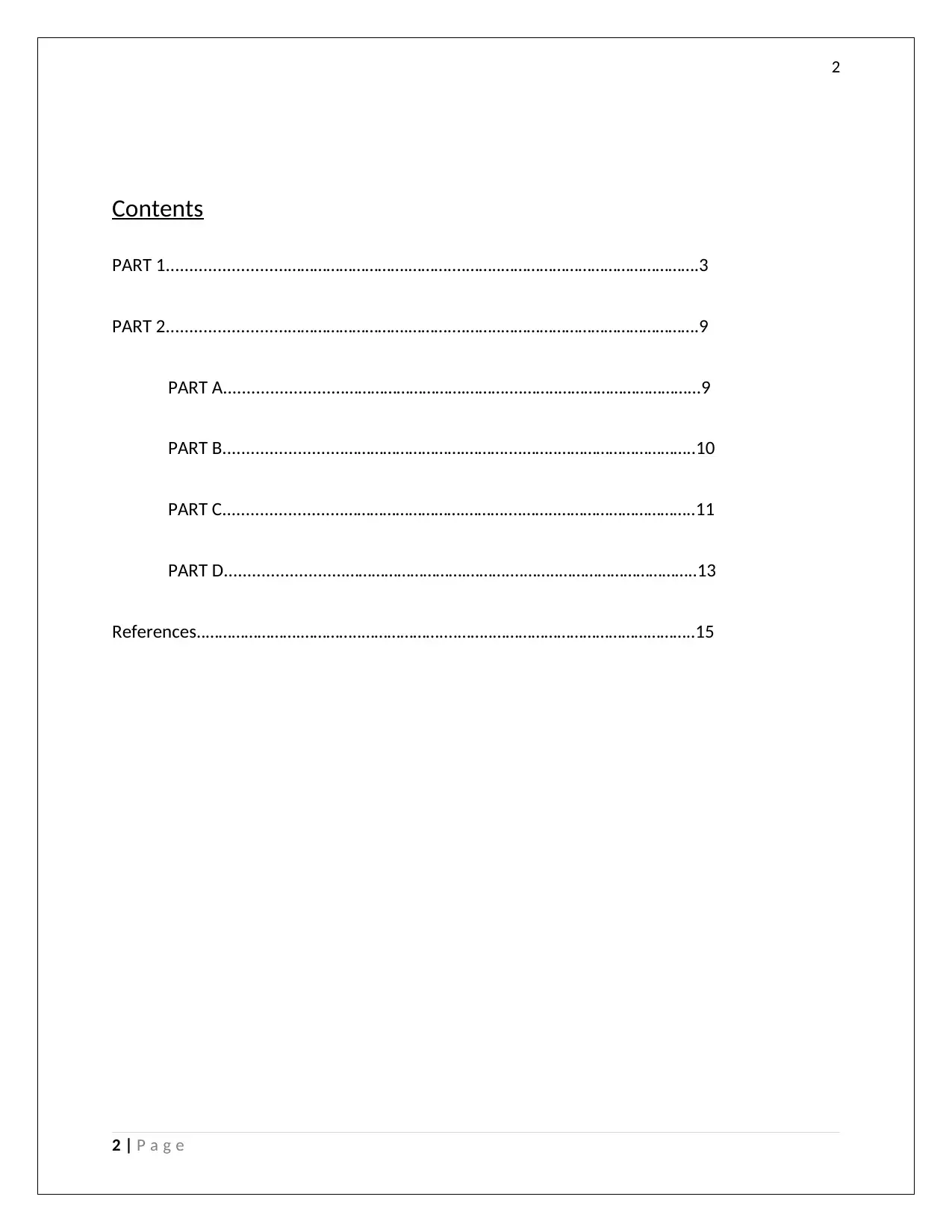
2
Contents
PART 1..........................……………………….………....……..……………………………………….3
PART 2..........................……………………….………....……..……………………………………….9
PART A..........................……………………….………....……..…………………………...9
PART B..........................……………………….………....……..…………………………..10
PART C..........................……………………….………....……..…………………………..11
PART D..........................……………………….………....……..…………………………..13
References..………………….…………..………………....……..………………………………………..15
2 | P a g e
Contents
PART 1..........................……………………….………....……..……………………………………….3
PART 2..........................……………………….………....……..……………………………………….9
PART A..........................……………………….………....……..…………………………...9
PART B..........................……………………….………....……..…………………………..10
PART C..........................……………………….………....……..…………………………..11
PART D..........................……………………….………....……..…………………………..13
References..………………….…………..………………....……..………………………………………..15
2 | P a g e
⊘ This is a preview!⊘
Do you want full access?
Subscribe today to unlock all pages.

Trusted by 1+ million students worldwide
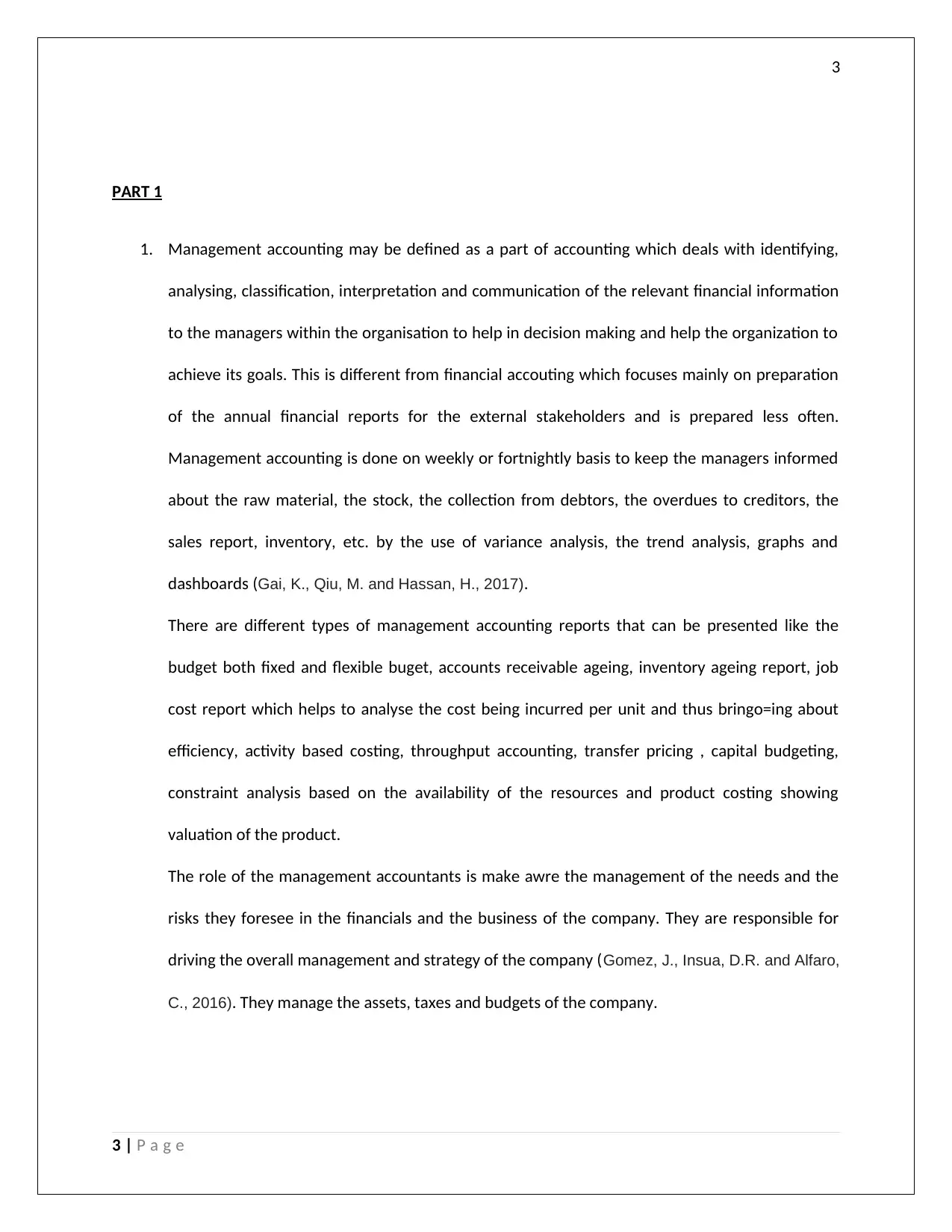
3
PART 1
1. Management accounting may be defined as a part of accounting which deals with identifying,
analysing, classification, interpretation and communication of the relevant financial information
to the managers within the organisation to help in decision making and help the organization to
achieve its goals. This is different from financial accouting which focuses mainly on preparation
of the annual financial reports for the external stakeholders and is prepared less often.
Management accounting is done on weekly or fortnightly basis to keep the managers informed
about the raw material, the stock, the collection from debtors, the overdues to creditors, the
sales report, inventory, etc. by the use of variance analysis, the trend analysis, graphs and
dashboards (Gai, K., Qiu, M. and Hassan, H., 2017).
There are different types of management accounting reports that can be presented like the
budget both fixed and flexible buget, accounts receivable ageing, inventory ageing report, job
cost report which helps to analyse the cost being incurred per unit and thus bringo=ing about
efficiency, activity based costing, throughput accounting, transfer pricing , capital budgeting,
constraint analysis based on the availability of the resources and product costing showing
valuation of the product.
The role of the management accountants is make awre the management of the needs and the
risks they foresee in the financials and the business of the company. They are responsible for
driving the overall management and strategy of the company (Gomez, J., Insua, D.R. and Alfaro,
C., 2016). They manage the assets, taxes and budgets of the company.
3 | P a g e
PART 1
1. Management accounting may be defined as a part of accounting which deals with identifying,
analysing, classification, interpretation and communication of the relevant financial information
to the managers within the organisation to help in decision making and help the organization to
achieve its goals. This is different from financial accouting which focuses mainly on preparation
of the annual financial reports for the external stakeholders and is prepared less often.
Management accounting is done on weekly or fortnightly basis to keep the managers informed
about the raw material, the stock, the collection from debtors, the overdues to creditors, the
sales report, inventory, etc. by the use of variance analysis, the trend analysis, graphs and
dashboards (Gai, K., Qiu, M. and Hassan, H., 2017).
There are different types of management accounting reports that can be presented like the
budget both fixed and flexible buget, accounts receivable ageing, inventory ageing report, job
cost report which helps to analyse the cost being incurred per unit and thus bringo=ing about
efficiency, activity based costing, throughput accounting, transfer pricing , capital budgeting,
constraint analysis based on the availability of the resources and product costing showing
valuation of the product.
The role of the management accountants is make awre the management of the needs and the
risks they foresee in the financials and the business of the company. They are responsible for
driving the overall management and strategy of the company (Gomez, J., Insua, D.R. and Alfaro,
C., 2016). They manage the assets, taxes and budgets of the company.
3 | P a g e
Paraphrase This Document
Need a fresh take? Get an instant paraphrase of this document with our AI Paraphraser
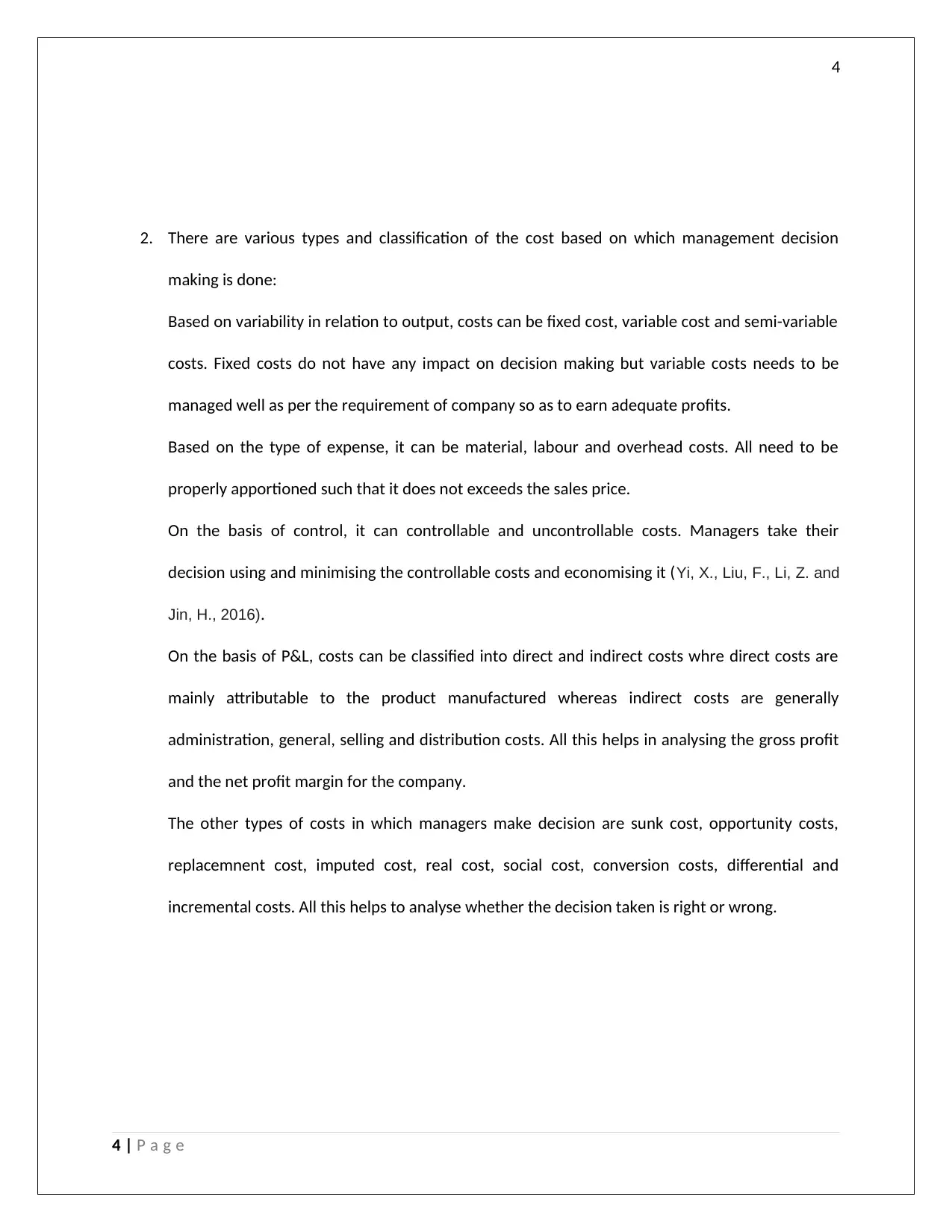
4
2. There are various types and classification of the cost based on which management decision
making is done:
Based on variability in relation to output, costs can be fixed cost, variable cost and semi-variable
costs. Fixed costs do not have any impact on decision making but variable costs needs to be
managed well as per the requirement of company so as to earn adequate profits.
Based on the type of expense, it can be material, labour and overhead costs. All need to be
properly apportioned such that it does not exceeds the sales price.
On the basis of control, it can controllable and uncontrollable costs. Managers take their
decision using and minimising the controllable costs and economising it (Yi, X., Liu, F., Li, Z. and
Jin, H., 2016).
On the basis of P&L, costs can be classified into direct and indirect costs whre direct costs are
mainly attributable to the product manufactured whereas indirect costs are generally
administration, general, selling and distribution costs. All this helps in analysing the gross profit
and the net profit margin for the company.
The other types of costs in which managers make decision are sunk cost, opportunity costs,
replacemnent cost, imputed cost, real cost, social cost, conversion costs, differential and
incremental costs. All this helps to analyse whether the decision taken is right or wrong.
4 | P a g e
2. There are various types and classification of the cost based on which management decision
making is done:
Based on variability in relation to output, costs can be fixed cost, variable cost and semi-variable
costs. Fixed costs do not have any impact on decision making but variable costs needs to be
managed well as per the requirement of company so as to earn adequate profits.
Based on the type of expense, it can be material, labour and overhead costs. All need to be
properly apportioned such that it does not exceeds the sales price.
On the basis of control, it can controllable and uncontrollable costs. Managers take their
decision using and minimising the controllable costs and economising it (Yi, X., Liu, F., Li, Z. and
Jin, H., 2016).
On the basis of P&L, costs can be classified into direct and indirect costs whre direct costs are
mainly attributable to the product manufactured whereas indirect costs are generally
administration, general, selling and distribution costs. All this helps in analysing the gross profit
and the net profit margin for the company.
The other types of costs in which managers make decision are sunk cost, opportunity costs,
replacemnent cost, imputed cost, real cost, social cost, conversion costs, differential and
incremental costs. All this helps to analyse whether the decision taken is right or wrong.
4 | P a g e
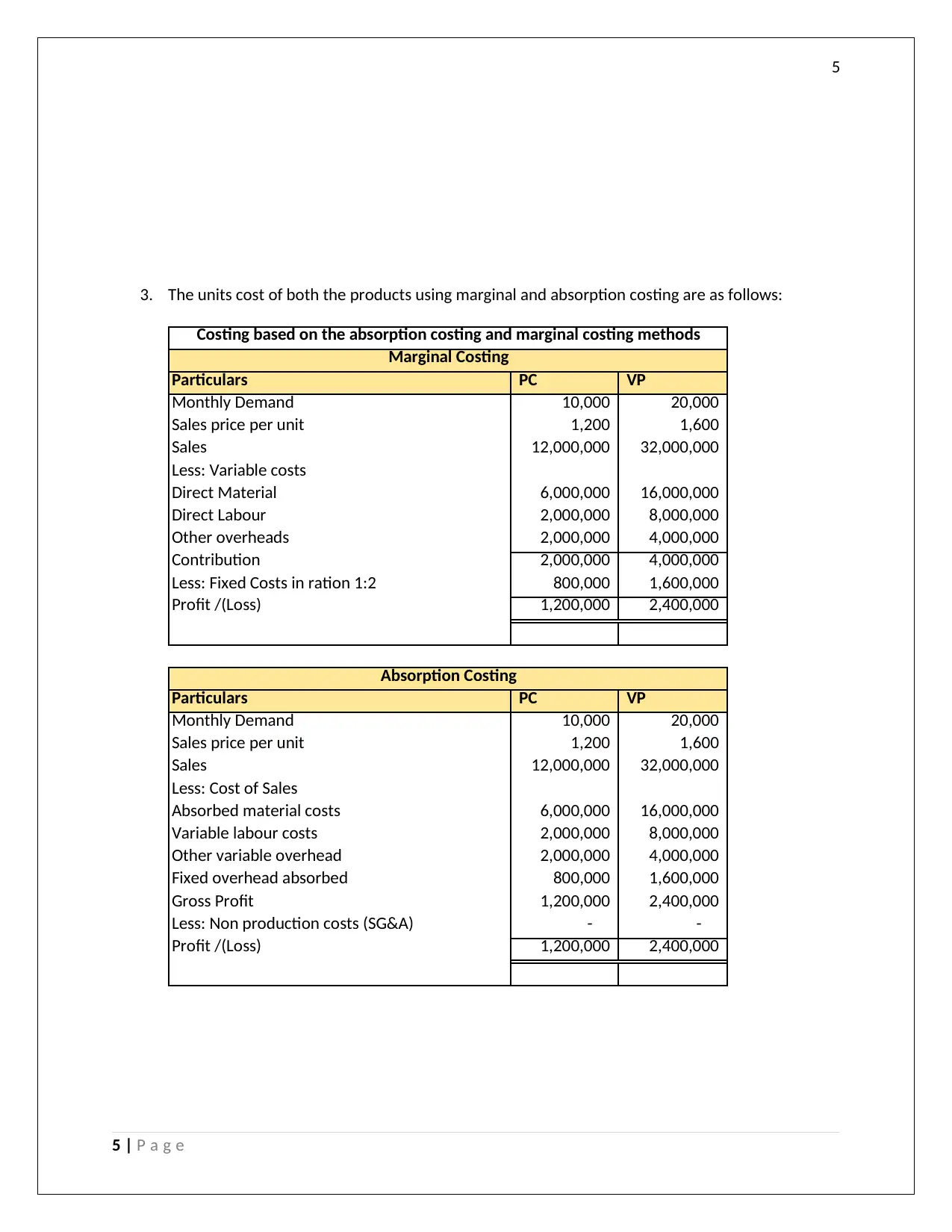
5
3. The units cost of both the products using marginal and absorption costing are as follows:
Particulars PC VP
Monthly Demand 10,000 20,000
Sales price per unit 1,200 1,600
Sales 12,000,000 32,000,000
Less: Variable costs
Direct Material 6,000,000 16,000,000
Direct Labour 2,000,000 8,000,000
Other overheads 2,000,000 4,000,000
Contribution 2,000,000 4,000,000
Less: Fixed Costs in ration 1:2 800,000 1,600,000
Profit /(Loss) 1,200,000 2,400,000
Particulars PC VP
Monthly Demand 10,000 20,000
Sales price per unit 1,200 1,600
Sales 12,000,000 32,000,000
Less: Cost of Sales
Absorbed material costs 6,000,000 16,000,000
Variable labour costs 2,000,000 8,000,000
Other variable overhead 2,000,000 4,000,000
Fixed overhead absorbed 800,000 1,600,000
Gross Profit 1,200,000 2,400,000
Less: Non production costs (SG&A) - -
Profit /(Loss) 1,200,000 2,400,000
Marginal Costing
Absorption Costing
Costing based on the absorption costing and marginal costing methods
5 | P a g e
3. The units cost of both the products using marginal and absorption costing are as follows:
Particulars PC VP
Monthly Demand 10,000 20,000
Sales price per unit 1,200 1,600
Sales 12,000,000 32,000,000
Less: Variable costs
Direct Material 6,000,000 16,000,000
Direct Labour 2,000,000 8,000,000
Other overheads 2,000,000 4,000,000
Contribution 2,000,000 4,000,000
Less: Fixed Costs in ration 1:2 800,000 1,600,000
Profit /(Loss) 1,200,000 2,400,000
Particulars PC VP
Monthly Demand 10,000 20,000
Sales price per unit 1,200 1,600
Sales 12,000,000 32,000,000
Less: Cost of Sales
Absorbed material costs 6,000,000 16,000,000
Variable labour costs 2,000,000 8,000,000
Other variable overhead 2,000,000 4,000,000
Fixed overhead absorbed 800,000 1,600,000
Gross Profit 1,200,000 2,400,000
Less: Non production costs (SG&A) - -
Profit /(Loss) 1,200,000 2,400,000
Marginal Costing
Absorption Costing
Costing based on the absorption costing and marginal costing methods
5 | P a g e
⊘ This is a preview!⊘
Do you want full access?
Subscribe today to unlock all pages.

Trusted by 1+ million students worldwide
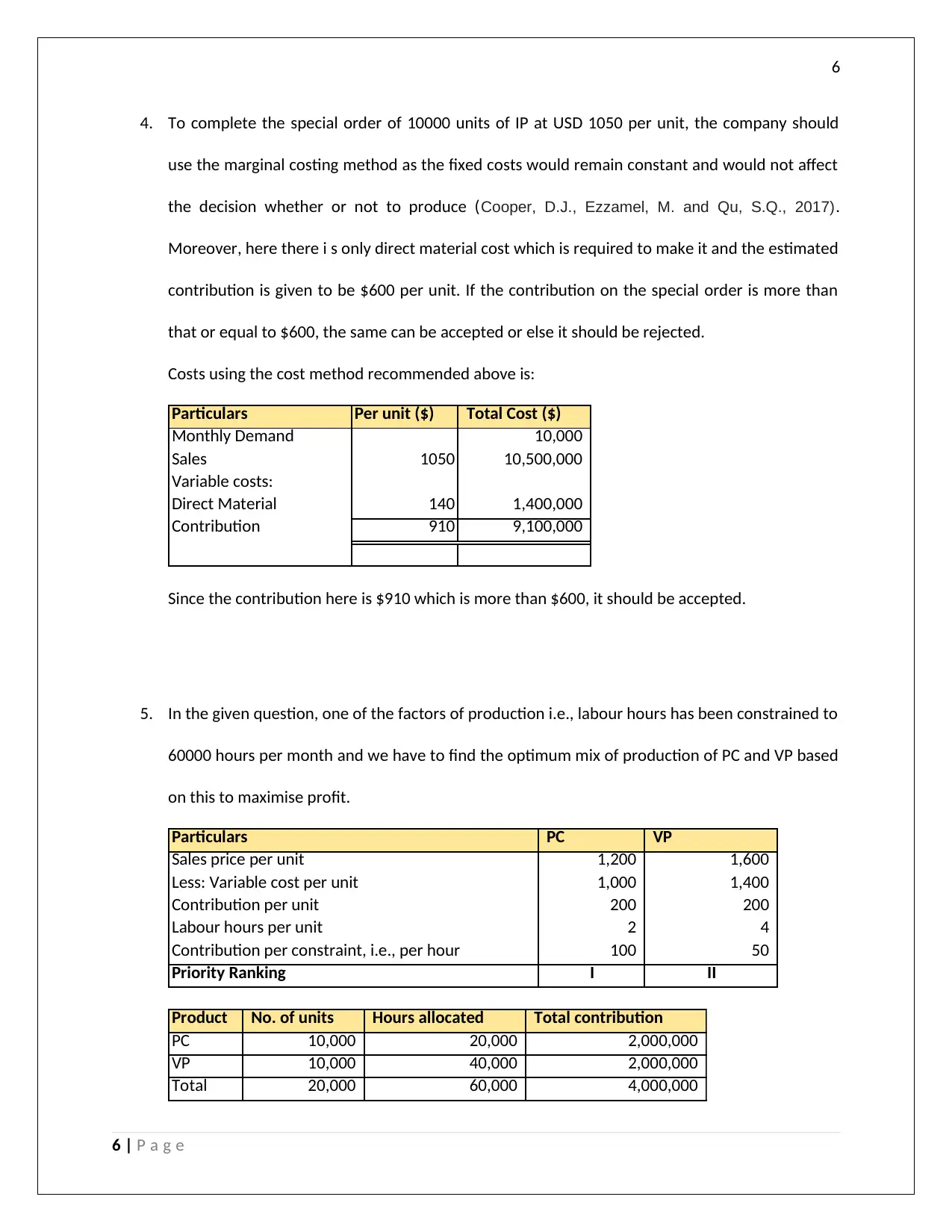
6
4. To complete the special order of 10000 units of IP at USD 1050 per unit, the company should
use the marginal costing method as the fixed costs would remain constant and would not affect
the decision whether or not to produce (Cooper, D.J., Ezzamel, M. and Qu, S.Q., 2017).
Moreover, here there i s only direct material cost which is required to make it and the estimated
contribution is given to be $600 per unit. If the contribution on the special order is more than
that or equal to $600, the same can be accepted or else it should be rejected.
Costs using the cost method recommended above is:
Particulars Per unit ($) Total Cost ($)
Monthly Demand 10,000
Sales 1050 10,500,000
Variable costs:
Direct Material 140 1,400,000
Contribution 910 9,100,000
Since the contribution here is $910 which is more than $600, it should be accepted.
5. In the given question, one of the factors of production i.e., labour hours has been constrained to
60000 hours per month and we have to find the optimum mix of production of PC and VP based
on this to maximise profit.
Particulars PC VP
Sales price per unit 1,200 1,600
Less: Variable cost per unit 1,000 1,400
Contribution per unit 200 200
Labour hours per unit 2 4
Contribution per constraint, i.e., per hour 100 50
Priority Ranking I II
Product No. of units Hours allocated Total contribution
PC 10,000 20,000 2,000,000
VP 10,000 40,000 2,000,000
Total 20,000 60,000 4,000,000
6 | P a g e
4. To complete the special order of 10000 units of IP at USD 1050 per unit, the company should
use the marginal costing method as the fixed costs would remain constant and would not affect
the decision whether or not to produce (Cooper, D.J., Ezzamel, M. and Qu, S.Q., 2017).
Moreover, here there i s only direct material cost which is required to make it and the estimated
contribution is given to be $600 per unit. If the contribution on the special order is more than
that or equal to $600, the same can be accepted or else it should be rejected.
Costs using the cost method recommended above is:
Particulars Per unit ($) Total Cost ($)
Monthly Demand 10,000
Sales 1050 10,500,000
Variable costs:
Direct Material 140 1,400,000
Contribution 910 9,100,000
Since the contribution here is $910 which is more than $600, it should be accepted.
5. In the given question, one of the factors of production i.e., labour hours has been constrained to
60000 hours per month and we have to find the optimum mix of production of PC and VP based
on this to maximise profit.
Particulars PC VP
Sales price per unit 1,200 1,600
Less: Variable cost per unit 1,000 1,400
Contribution per unit 200 200
Labour hours per unit 2 4
Contribution per constraint, i.e., per hour 100 50
Priority Ranking I II
Product No. of units Hours allocated Total contribution
PC 10,000 20,000 2,000,000
VP 10,000 40,000 2,000,000
Total 20,000 60,000 4,000,000
6 | P a g e
Paraphrase This Document
Need a fresh take? Get an instant paraphrase of this document with our AI Paraphraser
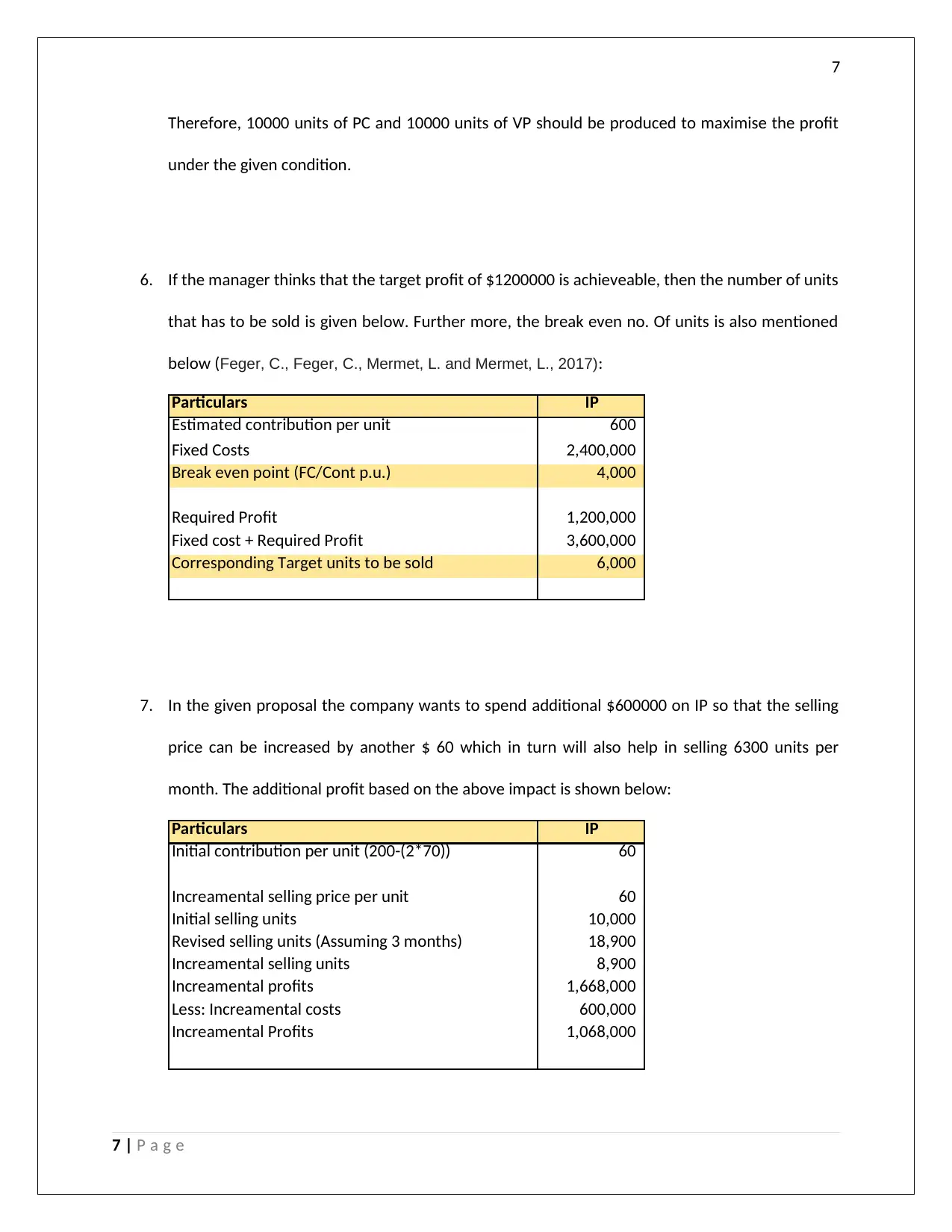
7
Therefore, 10000 units of PC and 10000 units of VP should be produced to maximise the profit
under the given condition.
6. If the manager thinks that the target profit of $1200000 is achieveable, then the number of units
that has to be sold is given below. Further more, the break even no. Of units is also mentioned
below (Feger, C., Feger, C., Mermet, L. and Mermet, L., 2017):
Particulars IP
Estimated contribution per unit 600
Fixed Costs 2,400,000
Break even point (FC/Cont p.u.) 4,000
Required Profit 1,200,000
Fixed cost + Required Profit 3,600,000
Corresponding Target units to be sold 6,000
7. In the given proposal the company wants to spend additional $600000 on IP so that the selling
price can be increased by another $ 60 which in turn will also help in selling 6300 units per
month. The additional profit based on the above impact is shown below:
Particulars IP
Initial contribution per unit (200-(2*70)) 60
Increamental selling price per unit 60
Initial selling units 10,000
Revised selling units (Assuming 3 months) 18,900
Increamental selling units 8,900
Increamental profits 1,668,000
Less: Increamental costs 600,000
Increamental Profits 1,068,000
7 | P a g e
Therefore, 10000 units of PC and 10000 units of VP should be produced to maximise the profit
under the given condition.
6. If the manager thinks that the target profit of $1200000 is achieveable, then the number of units
that has to be sold is given below. Further more, the break even no. Of units is also mentioned
below (Feger, C., Feger, C., Mermet, L. and Mermet, L., 2017):
Particulars IP
Estimated contribution per unit 600
Fixed Costs 2,400,000
Break even point (FC/Cont p.u.) 4,000
Required Profit 1,200,000
Fixed cost + Required Profit 3,600,000
Corresponding Target units to be sold 6,000
7. In the given proposal the company wants to spend additional $600000 on IP so that the selling
price can be increased by another $ 60 which in turn will also help in selling 6300 units per
month. The additional profit based on the above impact is shown below:
Particulars IP
Initial contribution per unit (200-(2*70)) 60
Increamental selling price per unit 60
Initial selling units 10,000
Revised selling units (Assuming 3 months) 18,900
Increamental selling units 8,900
Increamental profits 1,668,000
Less: Increamental costs 600,000
Increamental Profits 1,068,000
7 | P a g e
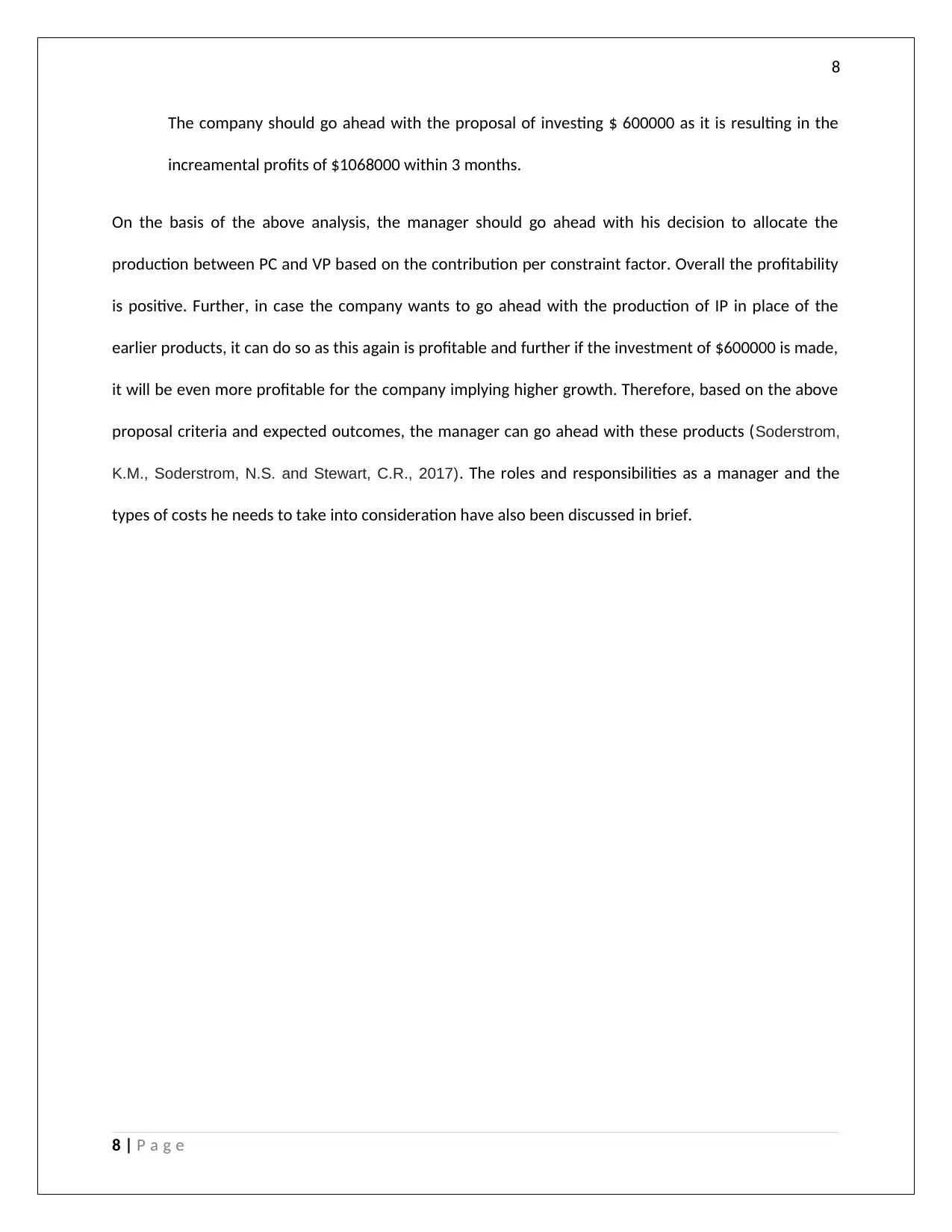
8
The company should go ahead with the proposal of investing $ 600000 as it is resulting in the
increamental profits of $1068000 within 3 months.
On the basis of the above analysis, the manager should go ahead with his decision to allocate the
production between PC and VP based on the contribution per constraint factor. Overall the profitability
is positive. Further, in case the company wants to go ahead with the production of IP in place of the
earlier products, it can do so as this again is profitable and further if the investment of $600000 is made,
it will be even more profitable for the company implying higher growth. Therefore, based on the above
proposal criteria and expected outcomes, the manager can go ahead with these products (Soderstrom,
K.M., Soderstrom, N.S. and Stewart, C.R., 2017). The roles and responsibilities as a manager and the
types of costs he needs to take into consideration have also been discussed in brief.
8 | P a g e
The company should go ahead with the proposal of investing $ 600000 as it is resulting in the
increamental profits of $1068000 within 3 months.
On the basis of the above analysis, the manager should go ahead with his decision to allocate the
production between PC and VP based on the contribution per constraint factor. Overall the profitability
is positive. Further, in case the company wants to go ahead with the production of IP in place of the
earlier products, it can do so as this again is profitable and further if the investment of $600000 is made,
it will be even more profitable for the company implying higher growth. Therefore, based on the above
proposal criteria and expected outcomes, the manager can go ahead with these products (Soderstrom,
K.M., Soderstrom, N.S. and Stewart, C.R., 2017). The roles and responsibilities as a manager and the
types of costs he needs to take into consideration have also been discussed in brief.
8 | P a g e
⊘ This is a preview!⊘
Do you want full access?
Subscribe today to unlock all pages.

Trusted by 1+ million students worldwide
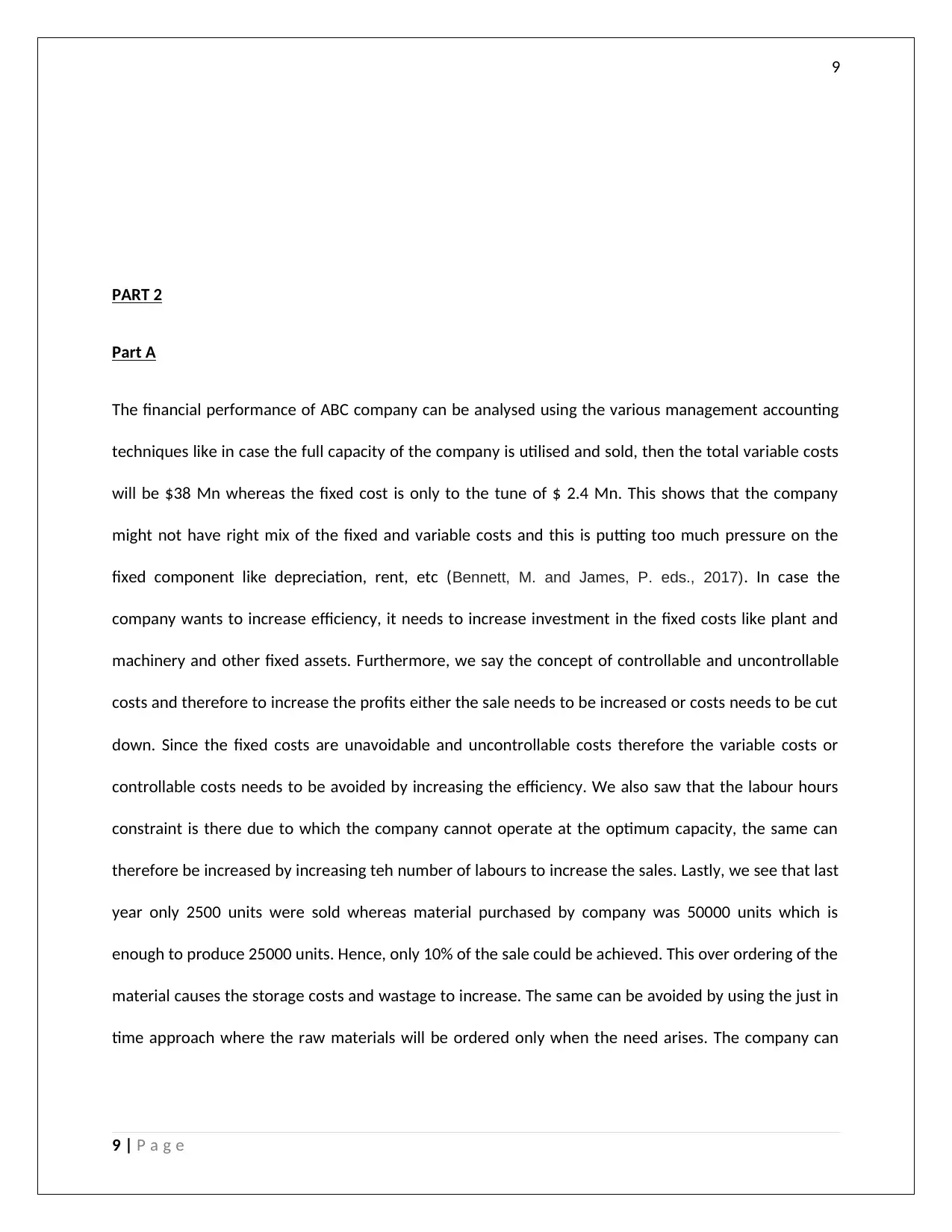
9
PART 2
Part A
The financial performance of ABC company can be analysed using the various management accounting
techniques like in case the full capacity of the company is utilised and sold, then the total variable costs
will be $38 Mn whereas the fixed cost is only to the tune of $ 2.4 Mn. This shows that the company
might not have right mix of the fixed and variable costs and this is putting too much pressure on the
fixed component like depreciation, rent, etc (Bennett, M. and James, P. eds., 2017). In case the
company wants to increase efficiency, it needs to increase investment in the fixed costs like plant and
machinery and other fixed assets. Furthermore, we say the concept of controllable and uncontrollable
costs and therefore to increase the profits either the sale needs to be increased or costs needs to be cut
down. Since the fixed costs are unavoidable and uncontrollable costs therefore the variable costs or
controllable costs needs to be avoided by increasing the efficiency. We also saw that the labour hours
constraint is there due to which the company cannot operate at the optimum capacity, the same can
therefore be increased by increasing teh number of labours to increase the sales. Lastly, we see that last
year only 2500 units were sold whereas material purchased by company was 50000 units which is
enough to produce 25000 units. Hence, only 10% of the sale could be achieved. This over ordering of the
material causes the storage costs and wastage to increase. The same can be avoided by using the just in
time approach where the raw materials will be ordered only when the need arises. The company can
9 | P a g e
PART 2
Part A
The financial performance of ABC company can be analysed using the various management accounting
techniques like in case the full capacity of the company is utilised and sold, then the total variable costs
will be $38 Mn whereas the fixed cost is only to the tune of $ 2.4 Mn. This shows that the company
might not have right mix of the fixed and variable costs and this is putting too much pressure on the
fixed component like depreciation, rent, etc (Bennett, M. and James, P. eds., 2017). In case the
company wants to increase efficiency, it needs to increase investment in the fixed costs like plant and
machinery and other fixed assets. Furthermore, we say the concept of controllable and uncontrollable
costs and therefore to increase the profits either the sale needs to be increased or costs needs to be cut
down. Since the fixed costs are unavoidable and uncontrollable costs therefore the variable costs or
controllable costs needs to be avoided by increasing the efficiency. We also saw that the labour hours
constraint is there due to which the company cannot operate at the optimum capacity, the same can
therefore be increased by increasing teh number of labours to increase the sales. Lastly, we see that last
year only 2500 units were sold whereas material purchased by company was 50000 units which is
enough to produce 25000 units. Hence, only 10% of the sale could be achieved. This over ordering of the
material causes the storage costs and wastage to increase. The same can be avoided by using the just in
time approach where the raw materials will be ordered only when the need arises. The company can
9 | P a g e
Paraphrase This Document
Need a fresh take? Get an instant paraphrase of this document with our AI Paraphraser
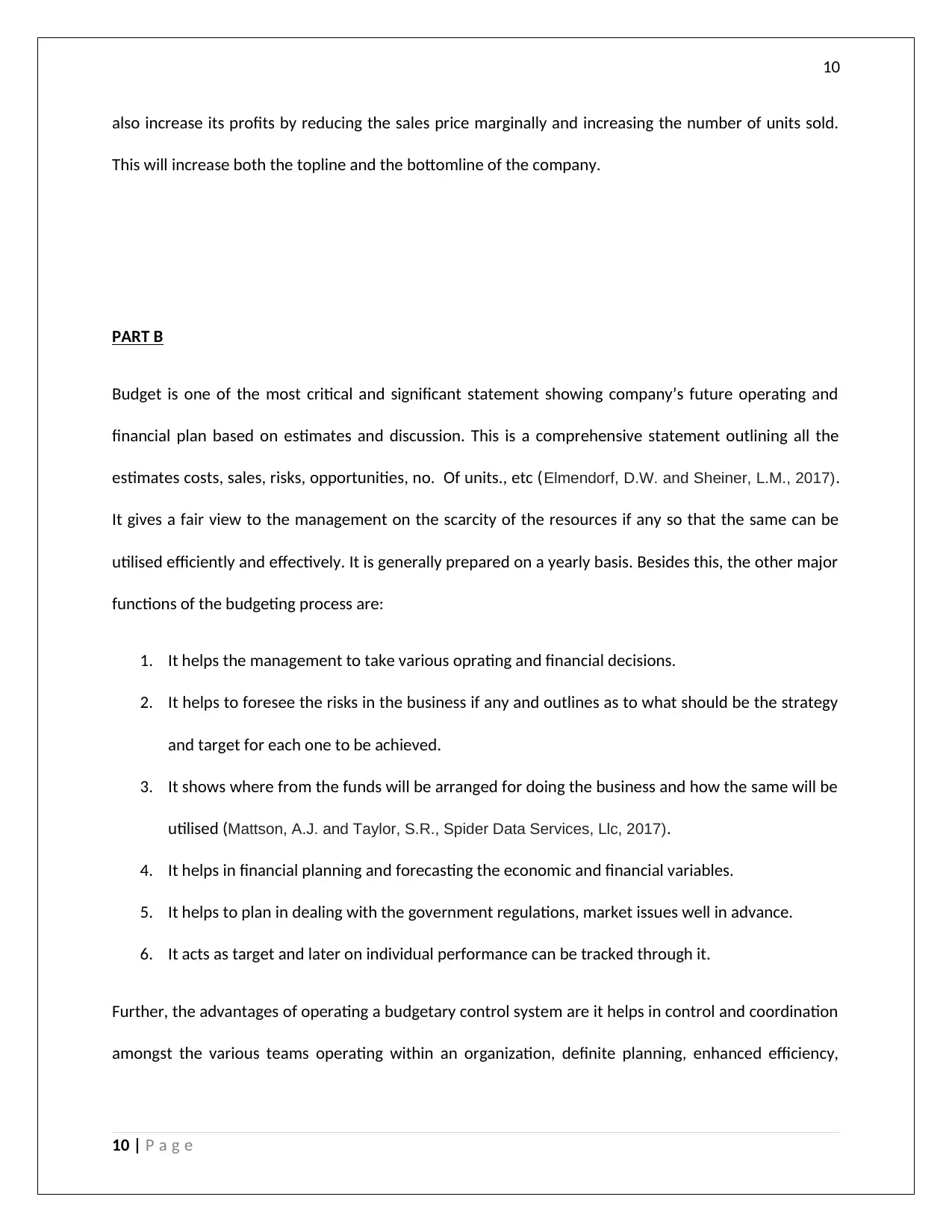
10
also increase its profits by reducing the sales price marginally and increasing the number of units sold.
This will increase both the topline and the bottomline of the company.
PART B
Budget is one of the most critical and significant statement showing company’s future operating and
financial plan based on estimates and discussion. This is a comprehensive statement outlining all the
estimates costs, sales, risks, opportunities, no. Of units., etc (Elmendorf, D.W. and Sheiner, L.M., 2017).
It gives a fair view to the management on the scarcity of the resources if any so that the same can be
utilised efficiently and effectively. It is generally prepared on a yearly basis. Besides this, the other major
functions of the budgeting process are:
1. It helps the management to take various oprating and financial decisions.
2. It helps to foresee the risks in the business if any and outlines as to what should be the strategy
and target for each one to be achieved.
3. It shows where from the funds will be arranged for doing the business and how the same will be
utilised (Mattson, A.J. and Taylor, S.R., Spider Data Services, Llc, 2017).
4. It helps in financial planning and forecasting the economic and financial variables.
5. It helps to plan in dealing with the government regulations, market issues well in advance.
6. It acts as target and later on individual performance can be tracked through it.
Further, the advantages of operating a budgetary control system are it helps in control and coordination
amongst the various teams operating within an organization, definite planning, enhanced efficiency,
10 | P a g e
also increase its profits by reducing the sales price marginally and increasing the number of units sold.
This will increase both the topline and the bottomline of the company.
PART B
Budget is one of the most critical and significant statement showing company’s future operating and
financial plan based on estimates and discussion. This is a comprehensive statement outlining all the
estimates costs, sales, risks, opportunities, no. Of units., etc (Elmendorf, D.W. and Sheiner, L.M., 2017).
It gives a fair view to the management on the scarcity of the resources if any so that the same can be
utilised efficiently and effectively. It is generally prepared on a yearly basis. Besides this, the other major
functions of the budgeting process are:
1. It helps the management to take various oprating and financial decisions.
2. It helps to foresee the risks in the business if any and outlines as to what should be the strategy
and target for each one to be achieved.
3. It shows where from the funds will be arranged for doing the business and how the same will be
utilised (Mattson, A.J. and Taylor, S.R., Spider Data Services, Llc, 2017).
4. It helps in financial planning and forecasting the economic and financial variables.
5. It helps to plan in dealing with the government regulations, market issues well in advance.
6. It acts as target and later on individual performance can be tracked through it.
Further, the advantages of operating a budgetary control system are it helps in control and coordination
amongst the various teams operating within an organization, definite planning, enhanced efficiency,
10 | P a g e
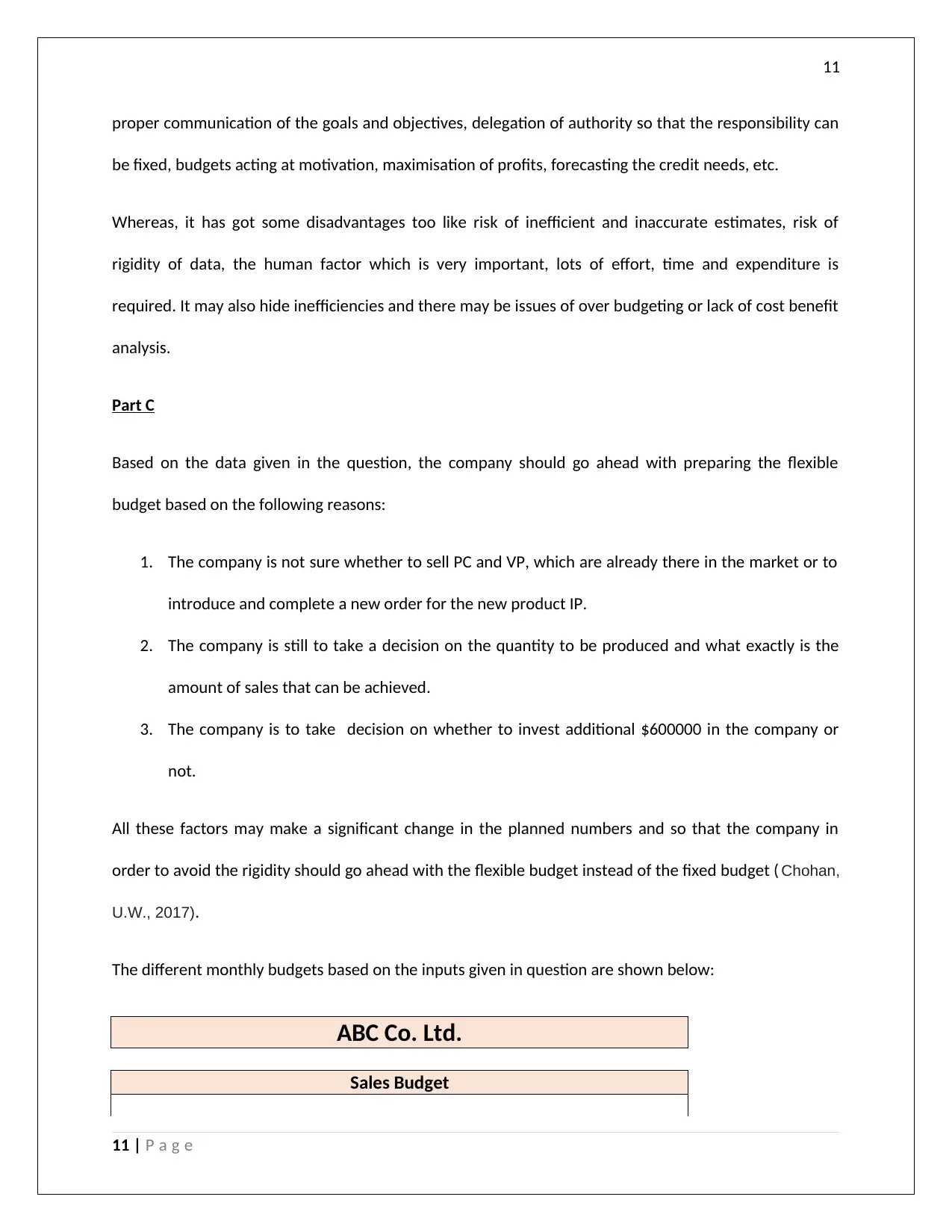
11
proper communication of the goals and objectives, delegation of authority so that the responsibility can
be fixed, budgets acting at motivation, maximisation of profits, forecasting the credit needs, etc.
Whereas, it has got some disadvantages too like risk of inefficient and inaccurate estimates, risk of
rigidity of data, the human factor which is very important, lots of effort, time and expenditure is
required. It may also hide inefficiencies and there may be issues of over budgeting or lack of cost benefit
analysis.
Part C
Based on the data given in the question, the company should go ahead with preparing the flexible
budget based on the following reasons:
1. The company is not sure whether to sell PC and VP, which are already there in the market or to
introduce and complete a new order for the new product IP.
2. The company is still to take a decision on the quantity to be produced and what exactly is the
amount of sales that can be achieved.
3. The company is to take decision on whether to invest additional $600000 in the company or
not.
All these factors may make a significant change in the planned numbers and so that the company in
order to avoid the rigidity should go ahead with the flexible budget instead of the fixed budget ( Chohan,
U.W., 2017).
The different monthly budgets based on the inputs given in question are shown below:
ABC Co. Ltd.
Sales Budget
11 | P a g e
proper communication of the goals and objectives, delegation of authority so that the responsibility can
be fixed, budgets acting at motivation, maximisation of profits, forecasting the credit needs, etc.
Whereas, it has got some disadvantages too like risk of inefficient and inaccurate estimates, risk of
rigidity of data, the human factor which is very important, lots of effort, time and expenditure is
required. It may also hide inefficiencies and there may be issues of over budgeting or lack of cost benefit
analysis.
Part C
Based on the data given in the question, the company should go ahead with preparing the flexible
budget based on the following reasons:
1. The company is not sure whether to sell PC and VP, which are already there in the market or to
introduce and complete a new order for the new product IP.
2. The company is still to take a decision on the quantity to be produced and what exactly is the
amount of sales that can be achieved.
3. The company is to take decision on whether to invest additional $600000 in the company or
not.
All these factors may make a significant change in the planned numbers and so that the company in
order to avoid the rigidity should go ahead with the flexible budget instead of the fixed budget ( Chohan,
U.W., 2017).
The different monthly budgets based on the inputs given in question are shown below:
ABC Co. Ltd.
Sales Budget
11 | P a g e
⊘ This is a preview!⊘
Do you want full access?
Subscribe today to unlock all pages.

Trusted by 1+ million students worldwide
1 out of 17
Related Documents
Your All-in-One AI-Powered Toolkit for Academic Success.
+13062052269
info@desklib.com
Available 24*7 on WhatsApp / Email
![[object Object]](/_next/static/media/star-bottom.7253800d.svg)
Unlock your academic potential
Copyright © 2020–2025 A2Z Services. All Rights Reserved. Developed and managed by ZUCOL.





